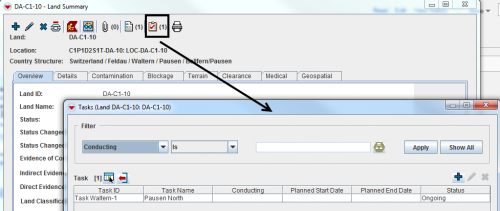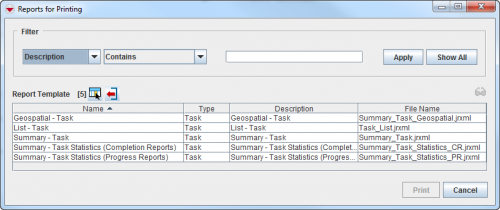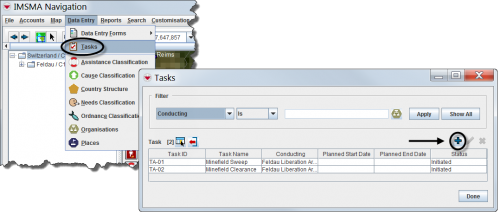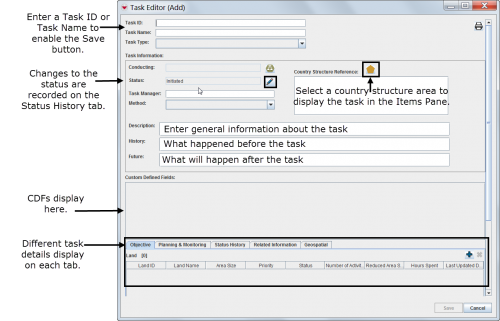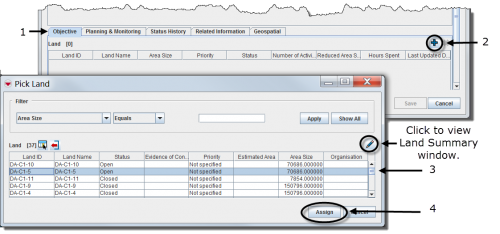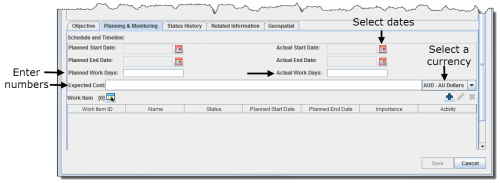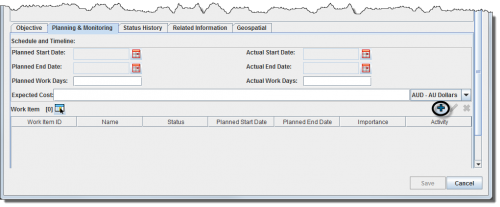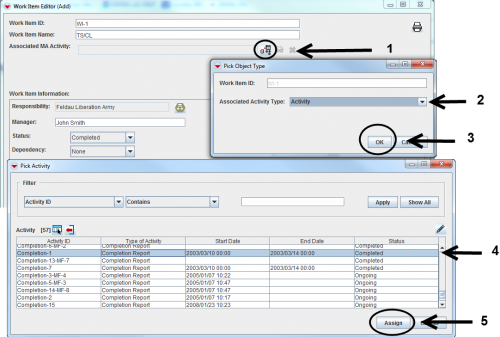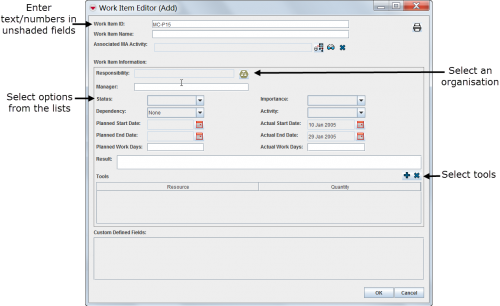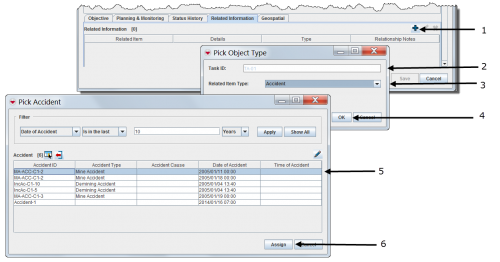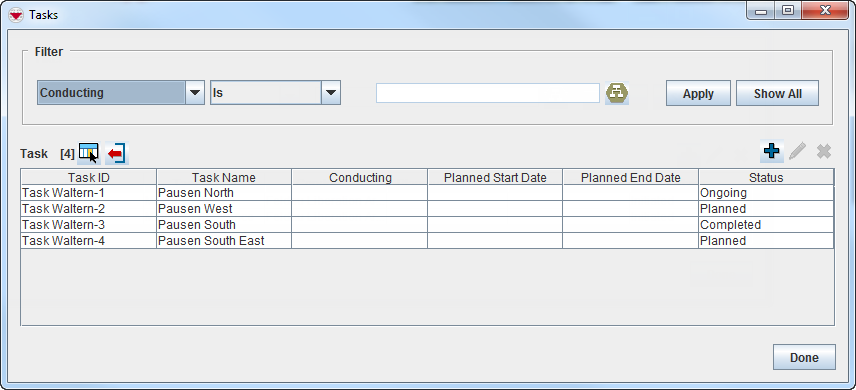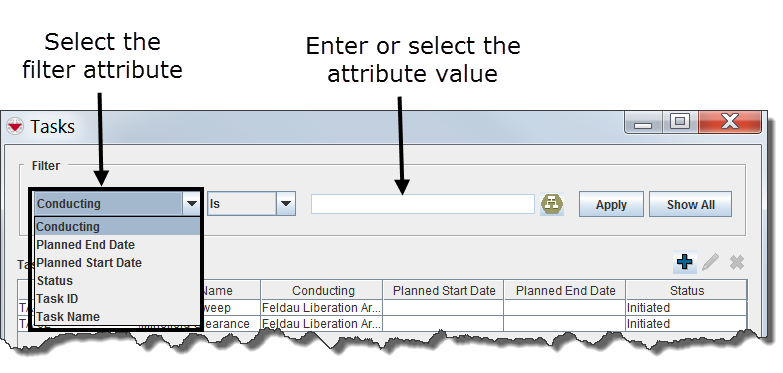Difference between revisions of "Using the Tasking Tool in IMSMANG"
(→Adding a New Task) |
(→Adding a New Task) |
||
| Line 295: | Line 295: | ||
<li>Select a hazard item record from the list on the Objective tab.</li> | <li>Select a hazard item record from the list on the Objective tab.</li> | ||
<li>Click the [[Image:EcksButton.png]] button.</li> | <li>Click the [[Image:EcksButton.png]] button.</li> | ||
| + | </ol> | ||
| + | |||
| + | ====Planning & Monitoring Tab==== | ||
| + | |||
| + | <p>The Planning & Monitoring tab allows you to assign task schedules and resources, such as work days, dates, and cost. You can also add and manage subtasks called work items. For more information about work items, refer to ''Work Item Editor''.</p> | ||
| + | <p>To set task schedules and resources:</p> | ||
| + | <ol>Click the '''Planning & Monitoring''' tab on the Task Editor window. | ||
| + | </ol> | ||
| + | |||
| + | [[Image:PlanningAndMonitoringTab.png|center|''Planning & Monitoring Tab Window'']] | ||
| + | <div align="center"> | ||
| + | ''Planning & Monitoring Tab Window'' | ||
| + | </div> | ||
| + | |||
| + | <ol start ="2"> | ||
| + | <li>In the '''Schedule and Timeline''' section, you can enter the following information:</li> | ||
| + | * The planned start date | ||
| + | * The planned end date | ||
| + | * The planned number of work days for completing the task | ||
| + | * The actual start date | ||
| + | * The actual end date | ||
| + | * The actual number of work days spent | ||
| + | * The expected cost and world currency | ||
</ol> | </ol> | ||
Revision as of 00:31, 22 January 2013
Depending on local standard operating procedures (SOPs), the tasking tool can be used to manage activities for one hazard or several hazards, or for monitoring a specific organisation that was tasked.
The tasking tool automatically retrieves data from the associated work items to produce statistics. This includes cleared area size, devices found and hours spent.
All the compiled information related to the specified task can be viewed and printed from the task manager or the Task Editor window.
| How To |
|---|
| Windows Vista and Windows 7 users, this sign next to a step is a reminder for you that you must right-click executables and choose Run as administrator from the context menu. |
Viewing Tasks
- Browsing tasks from the IMSMA Navigation window.
| Represents a tip or note for using IMSMA Mobile. | Tasks can be displayed in the items pane by selecting a specific country structure area. |
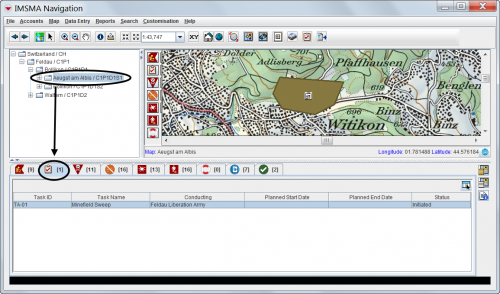
| |
- Viewing the associated task(s) of a specific item in the items pane
| Represents a tip or note for using IMSMA Mobile. | Only hazards, hazard reductions, MREs and QCs can have associated tasks. |
Printing a Task Summary
Entering New Tasks
| Represents a tip or note for using IMSMA Mobile. | Only hazards, hazard reductions, MREs and QCs can have associated tasks. |
| 500px | |
Completing General Information Details
Associating Objectives
| Represents a tip or note for using IMSMA Mobile. | The objective refers to a single or to several hazards that have the same task. |
Associating work items
- Select the Planning & Monitoring tab in the Task Editor window.
Adding Work Items
| Represents a tip or note for using IMSMA Mobile. | Work items can be updates or progress reports, planned or completed hazard reductions or QC/QA or MRE activities reporting on indicators that automatically update the Statistics tab. |
- Enter a work item ID or work item name to enable the OK button.
- Associate an MA activity field report.
- Enter general information about the work item.
| Represents a tip or note for using IMSMA Mobile. | After associating new objectives and work items, refresh the Statistics tab. |
| 500px | |
- Select the Related Information tab in the Task Editor window.
- Select auxiliary data, a field report item or a task.
Tasks allow you to manage work that is required as part of your mine action process. You can link tasks to standard IMSMA items or to specific areas on the map, assign task objectives and sub-tasks (called work items), and record other work-related information such as start and end dates, available resources, responsible personnel, and status changes.
Tasks Window
To access the Task window, select the Data Entry menu, and then select Tasks.
Tasks Window
From the Tasks window, you can:
- Filter the tasks listed in the window. For more information, refer to How to filter the tasks displayed.
- Select the columns that are displayed in the Tasks window. For more information, refer to Selecting display columns.
- Export the data displayed in the window. For more information, refer to Exporting.
- Add tasks. For more information, refer to How to add a new task.
- View or change task information. For more information, refer to How to view and/or change a task.
- Remove a task. For more information, refer to How to remove a task.
- Print a copy of the task and its details. For more information, refer to How to print a task.
Filtering the Tasks Displayed
By default, all tasks are listed in the table when the Tasks window is opened. You can limit the tasks displayed in the table by selecting specific filter attributes.
Filtering Tasks
To filter the tasks displayed in the Tasks window:
- From the Data Entry menu, select Tasks.
- The Tasks window displays.
- Select the attribute on which you would like to apply the filter from the Filter drop-down list. Filter options for tasks include:
- Current Owner – returns tasks owned by the organisation you selected from the list.
- Current Status – returns tasks with the status value that you selected from the list.
- Task ID – returns tasks with a task ID that contains the specified value.
- Task Name – returns tasks with a task name that contains the specified value.
- Enter or select a value that the selected attribute must be either similar to or contain. Note that the filter is not case-sensitive.
- Click the Apply button.
- Tasks passing the filter are listed in the table.
Adding a New Task
Click the ![]() button on the Tasks window.
button on the Tasks window.
- The Task Editor window displays.
Task Editor Window
The Task Editor window includes seven sections:
- A Basic Information section – This main section of the Task Editor window lets you enter standard data and save the task.
- An Objective tab – Use this tab to select a hazard item as the objective for the entire task.
- A Planning & Monitoring tab – Use this tab to set schedules and timelines for the task, and to create Work Items.
- A Statistics tab – Use this tab to display various metrics about the task.
- A Status History tab – Use this tab to display the revision history of the task.
- A Related Information tab – Use this tab to add information that is relevant to the task but does not affect its completion.
- A Geospatial Data tab – Use this tab to manage geospatial data (such as points, polygons, and polylines) that are associated with the task.
Basic Information
- Enter an identification number for the task in the Task ID field.
- Enter a name for the task in the Task Name field.
- Select an option from the Task Type menu to indicate the type of hazard dealt with.
| Represents a tip or note for using IMSMA Mobile. | Default Task Type options include: Battle Area Subsurface, Battle Area Surface, Cluster Strike Subsurface, Cluster Strike Surface, Complex, Minefield, UXO Spot.
Note that Task Type options can be customised using the Data Inventory Manager. |
- Click the File:OrgInfoIcon.png button to select an organisation as the task owner.
- Click the File:StrucInfoIcon.png button to select an associated country structure level.
| Represents a tip or note for using IMSMA Mobile. | For general information about adding auxiliary data such as organisations and country structure levels, refer to How to enter country structure data in the field report and How to enter organisation data in the field report. |
- Click the
 button to open the Task Status (Add) window. From here, you can view the current status of the task, or select a new status from the menu whenever the task is updated.
button to open the Task Status (Add) window. From here, you can view the current status of the task, or select a new status from the menu whenever the task is updated.
| Represents a tip or note for using IMSMA Mobile. | Data entered in the Task Status (Add) window is also stored in the Status History tab. For more information, refer to Status History Tab. |
Task Status (Add) Window
- Enter the name of the person who is in charge of the task in the Task Manager field.
- Select an option from the Method menu to indicate the type of task being performed.
| Represents a tip or note for using IMSMA Mobile. | Method options include: Clearance, Combine, Non-Technical Survey, Not Specified, Survey, Technical Survey. |
- Use the Description, History, and Future fields to provide the task manager with relevant background information about the task.
- In the Custom Defined Fields section, enter data into whatever custom defined fields (CDFs) are displayed.
| Represents a tip or note for using IMSMA Mobile. | You can use the Data Inventory Manager to create your own CDFs and add them to the Work Item Editor window. For more information, refer to Custom Defined Fields (CDF). |
- Click the Save button to save the task.
| Represents a tip or note for using IMSMA Mobile. | The Save button only becomes available after you enter either a Task ID or a Task Name. |
Objective Tab
If your task was created to address a specific Hazard in IMSMA, you may assign that Hazard as the Objective of your task.
To add an objective:
- Click the Objective tab on the Task Editor window.
- Click the
 button on the Objective tab.
button on the Objective tab. - The Pick Hazard window displays.
Pick Hazard Window
| Represents a tip or note for using IMSMA Mobile. | You can customise the Pick Hazard window in the following ways:
|
- Use the Filter section to display a list of hazard item records.
- Select an item record from the list.
- Click the Assign button.
- The selected item record displays in the Objective tab.
| Represents a tip or note for using IMSMA Mobile. | You can select an already-closed hazard as the objective, but you will be prompted to confirm your choice. |
To remove an objective from the list:
Planning & Monitoring Tab
The Planning & Monitoring tab allows you to assign task schedules and resources, such as work days, dates, and cost. You can also add and manage subtasks called work items. For more information about work items, refer to Work Item Editor.
To set task schedules and resources:
- Click the Planning & Monitoring tab on the Task Editor window.
Planning & Monitoring Tab Window
- In the Schedule and Timeline section, you can enter the following information:
- The planned start date
- The planned end date
- The planned number of work days for completing the task
- The actual start date
- The actual end date
- The actual number of work days spent
- The expected cost and world currency
Viewing or Changing a Task
To view and/or change task information:
- From the Tasks window, select the row associated with the task you would like to view or change.
- Click the
 button.
button. - Change the information as needed. For more information about editing the various data entry fields, refer to How to add a new task.
- Do one of the following:
- To save the changes you have made to the task, click Save.
- To discard any changes you have made, click Cancel.
Removing a Task
| Represents a tip or note for using IMSMA Mobile. | Not all tasks can be removed. You cannot remove tasks that contain Objectives or Work Items. However, you can remove tasks that are linked to Related Items. |
To remove a task:
- From the Tasks window, click the row associated with the task you would like to remove.
- Click the
 button.
button. - The Verify Deletion window displays.
- Do one of the following:
- To delete the task, click the Yes button.
- The Task is removed.
- To cancel the delete operation, click the No button.
Printing a Task
To print a hard copy of the task information:
